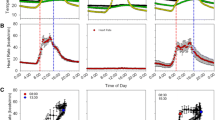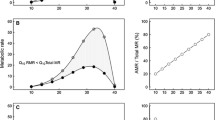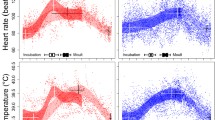Abstract
The present study determined whether EEG and/or EMG recordings could be used to reliably define activity states in the Brazilian black and white tegu lizard (Tupinambis merianae) and then examined the interactive effects of temperature and activity states on strategies for matching O2 supply and demand. In a first series of experiments, the rate of oxygen consumption (\(\dot{V}_{{{\text{O}}_{ 2} }}\)), breathing frequency (f R), heart rate (f H), and EEG and EMG (neck muscle) activity were measured in different sleep/wake states (sleeping, awake but quiet, alert, or moving). In general, metabolic and cardio-respiratory changes were better indictors of the transition from sleep to wake than were changes in the EEG and EMG. In a second series of experiments, the interactive effects of temperature (17, 27 and 37 °C) and activity states on f R, tidal volume (V T), the fraction of oxygen extracted from the lung per breath (FIO2–FEO2), f H, and the cardiac O2 pulse were quantified to determine the relative roles of each of these variables in accommodating changes in \(\dot{V}_{{{\text{O}}_{ 2} }}\). The increases in oxygen supply to meet temperature- and activity-induced increases in oxygen demand were produced almost exclusively by increases in f H and f R. Regression analysis showed that the effects of temperature and activity state on the relationships between f H, f R and \(\dot{V}_{{{\text{O}}_{ 2} }}\) was to extend a common relationship along a single curve, rather than separate relationships for each metabolic state. For these lizards, the predictive powers of f R and f H were maximized when the effects of changes in temperature, digestive state and activity were pooled. However, the best r 2 values obtained were 0.63 and 0.74 using f R and f H as predictors of met abolic rate, respectively.







Similar content being viewed by others
References
Abe AS (1983) Observations on dormancy in tegu lizards, Tupinambis teguixin (Reptilia, Teiidae). Naturalia 8:235–239
Abe AS (1995) Estivation in South American amphibians and reptiles. Braz J Med Biol Res 28:1241–1247
Andrade DV, Abe AS (1999) Gas exchange and ventilation during dormancy in the tegu lizard Tupinambis merianae. J Exp Biol 202:3677–3685
Armstrong JD (1986) Heart rate as an indicator of activity, metabolic rate, food intake and digestion in pike, Esox lucius. J Fish Biol 29:207–221
Ayala-Guerrero F, Huitron-Resendiz S (1991) Sleep patterns in the lizard Ctenosaura pectinata. Physiol Behav 49:1305–1307
Ayala-Guerrero F, Calderon A, Perez MC (1988) Sleep patterns in a chelonian reptile (Gopherus flavomarginatus). Physiol Behav 44:333–337
Bennett AF (1972) The effect of activity on oxygen consumption, oxygen debt, and heart rate in the lizards Varanus gouldii and Sauromalus hispidus. J Comp Physiol B 79:259–280
Bennett AF, Dawson WR (1976) Metabolism. In: Gans C, Dawson WR (eds) Biology of the reptilia. Academic Press, London, pp 127–223
Bevan R, Woakes A, Butler P, Boyd I (1994) The use of heart rate to estimate oxygen consumption of free-ranging black-browed albatrosses, Diomedea melanophrys. J Exp Biol 193:119–137
Bevan RM, Speakman JR, Butler PJ (1995) Daily energy expenditure of tufted ducks: a comparison between indirect calorimetry, doubly labelled water and heart rate. Funct Ecol 9:40–47
Butler PJ (1993) To what extent can heart rate be used as an indicator of metabolic rate in free-living marine mammals? In: Boyd IL (ed) Recent advances in marine mammal science. Oxford University Press, Oxford, pp 317–332
Butler P, Woakes A, Boyd I, Kanatous S (1992) Relationship between heart rate and oxygen consumption during steady-state swimming in California sea lions. J Exp Biol 170:35–42
Butler PJ, Woakes AJ, Bevan RM, Stephenson R (2000) Heart rate and rate of oxygen consumption during flight of the barnacle goose, Branta leucopsis. Comp Biochem Physiol A 126:379–385
Butler PJ, Frappell PB, Wang T, Wikelski M (2002) The relationship between heart rate and rate of oxygen consumption in Galapagos marine iguanas (Amblyrhynchus cristatus) at two different temperatures. J Exp Biol 205:1917–1924
Claireaux G, Webber DM, Kerr SR, Boutilier RG (1995) Physiology and behaviour of free-swimming Atlantic cod (Gadus morhua) facing fluctuating temperature conditions. J Exp Biol 198:49–60
Clark TD, Butler PJ, Frappell PB (2003) The relationship between body temperature, heart rate and rate of oxygen consumption in Rosenberg’s goanna (Varanus rosenbergi) at various levels of activity is affected by time in captivity. Comp Biochem Physiol A 134:S22
Clark TD, Ryan T, Ingram BA, Woakes AJ, Butler PJ, Frappell PB (2005a) Factorial aerobic scope is independent of temperature and primarily modulated by heart rate in exercising Murray cod (Maccullochella peelii peelii). Physiol Biochem Zool 78:347–355
Clark TD, Wang T, Butler PJ, Frappell PB (2005b) Factorial scope of cardio-metabolic variables remains constant with changes in body temperature in the varanid lizard, Varanus rosenbergi. Am J Physiol 288:R992–R997
Clark TD, Butler PJ, Frappell PB (2006) Factors influencing the prediction of metabolic rate in a reptile. Funct Ecol 20:105–113
de Souza SCR, de Carvalho JE, Abe AS, Bicudo JEPW, Bianconcini MSC (2004) Seasonal metabolic depression, substrate utilisation and changes in scaling patterns during the first year cycle of tegu lizards (Tupinambis merianae). J Exp Biol 207:307–318
De Vera L, Gonzalez J, Rial RV (1994) Reptilian waking EEG: slow waves, spindles and evoked potentials. Electroenecphalogr Clin Neurophysiol 90:298–303
Ettinger AO, King JR (1980) Time and energy budgets of the Willow Flycatcher (Empidonax traillii) during the breeding season. Auk 97:533–546
Fahlman A, Handrich Y, Woakes AJ, Bost CA, Holder R, Duchamp C, Butler PJ (2004) Effect of fasting on the VO2–f H relationship in king penguins, Aptenodytes patagonicus. Am J Physiol 287:R870–R877
Fedak MA, Pullen MR, Kanwisher J (1988) Circulatory responses of seals to periodic breathing: heart rate and breathing during exercise and diving in the laboratory and open sea. Can J Zool 66:53–60
Flanigan WF (1973) Sleep and wakefulness in Iguanid lizards, Ctenosaura pectinata and Iguana iguana. Brain Behav Evol 8:401–436
Flanigan WF, Wilcox RH, Rechtschaffen A (1973) The EEG and behavioural continuum of the crocodilian Caiman sclerops. Electroencephalogr Clin Neurophysiol 43:521–538
Frappell PB, Schultz TJ, Christian KA (2002) Oxygen transfer during aerobic exercise in a varanid lizard Varanus mertensi is limited by the circulation. J Exp Biol 205:2725–2736
Froget G, Butler P, Handrich Y, Woakes A (2001) Heart rate as an indicator of oxygen consumption: influence of body condition in the king penguin. J Exp Biol 204:2133–2144
Froget G, Handrich Y, Le Maho Y, Rouanet J-L, Woakes A, Butler P (2002) The heart rate/oxygen consumption relationship during cold exposure of the king penguin: a comparison with that during exercise. J Exp Biol 205:2511–2517
Glass ML, Wood SC, Johansen K (1978) The application of pneumotachography on small unrestrained animals. Comp Biochem Physiol 59A:425–427
Gleeson TT, Mitchell GS, Bennett AF (1980) Cardiovascular responses to graded activity in the lizards Varanus and Iguana. Am J Physiol 239:R174–R179
Green JA, Frappell PB (2007) Improving the precision and accuracy of estimates made using the heart rate method. Physiol Biochem Zool 80:551–555
Green J, Butler P, Woakes A, Boyd I, Holder R (2001) Heart rate and rate of oxygen consumption of exercising macaroni penguins. J Exp Biol 204:673–684
Green JA, Frappell PB, Clark TD, Butler PJ (2008) Predicting rate of oxygen consumption from heart rate while little penguins work rest and play. Comp Biochem Physiol 150A:222–230
Grubb B, Jorgensen DD, Conner M (1983) Cardiovascular changes in the exercising emu. J Exp Biol 104:193–201
Hawkins P, Butler P, Woakes A, Speakman J (2000) Estimation of the rate of oxygen consumption of the common eider duck (Somateria mollissima), with some measurements of heart rate during voluntary dives. J Exp Biol 203:2819–2832
Hicks JW, Riedesel ML (1983) Diurnal ventilatory patterns in the garter snake, Thamnophis elegans. J Comp Physiol 149:503–510
Hicks JW, Wang T, Bennett AF (2000) Patterns of cardiovascular and ventilatory response to elevated metabolic states in the lizard Varanus exanthematicus. J Exp Biol 203:2437–2445
Huntley AC (1987) Electrophysiological and behavioral correlates of sleep in the desert iguana Dipsosaurus dorsalis Hallowell. Comp Biochem Physiol 86A:325–330
Klein W, Andrade DV, Abe AS, Perry SF (2003) Role of the post-hepatic septum on breathing during locomotion in Tupinambis merianae (Reptilia: Teiidae). J Exp Biol 206:2135–2143
Klein W, Perry SF, Abe AS, Andrade DV (2006) Metabolic response to feeding in Tupinambis merianae: circadian rhythm and possible respiratory constraint. Physiol Biochem Zool 79:593–601
Lucas MC (1994) Heart rate as an indicator of metabolic rate and activity in adult Atlantic salmon, Salmo salar. J Fish Biol 44:889–903
Meglasson MD, Huggins SE (1979) Sleep in a crocodilian, Caiman sclerops. Comp Biochem Physiol 63A:561–567
Milsom WK, Andrade DV, BritoSP Toledo LF, Wang T, Abe AS (2008) Seasonal changes in daily metabolic patterns of tegu lizards (Tupinambis merianae) placed in the cold (17 °C) and dark. Physiol Biochem Zool 81:158–164
Rechtschaffen A, Kales A, Berger RJ, Dement WC, Jacobson A, Johnson LC, Jouvet M, Monroe LJ, Oswald I, Roffward HP, Roth B, Walter RD (1968) A manual of standardized terminology, techniques and scoring system for sleep stages of human subjects. US Government Printing Office, Washington, DC
Revell TK, Dunbar SG (2007) The energetic savings of sleep versus temperature in the Desert Iguan (Dipsosaurus dorsalis) at three ecologically relevant temperatures. Comp Biochem Phys A 148:393–398
Rial R, Nicolau MC, Lopez-Garcia JA, Almirall H (1993) Mini review: on the evolution of waking and sleeping. Comp Biochem Physiol 104A:189–193
Skovgaard N, Wang T (2004) Cost of ventilation and effect of digestive state on the ventilatory response of the tegu lizard. Respir Physiol Neurobiol 141:85–97
Tauber ES, Rojas-Ramirez J, Peon RH (1968) Electrophysiological and behavioral correlates of wakefulness and sleep in the lizard, Ctenosaura pectinata. Electroencephalogr Clin Neurophysiol 24:424–433
Thorarensen H, Gallaugher PE, Farrell AP (1996) The limitations of heart rate as a predictor of metabolic rate in fish. J Fish Biol 49:226–236
Toledo LF, Brito SP, Milsom WK, Abe AS, Andrade DV (2008) Effects of changes in season, temperature and body mass on the standard metabolic rate of tegu lizards (Tupinambis merianae). Physiol Biochem Zool 81:165–175
Walker JM, Berger RJ (1973) A polygraphic study of the tortoise (Testudo denticulata): absence of electrophysiological signs of sleep. Brain Behav Evol 8:453–467
Wang T, Warburton SJ (1995) Breathing pattern and cost of ventilation in the American alligator. Respir Physiol 102:29–37
Ward S, Bishop CM, Woakes AJ, Butler PJ (2002) Heart rate and the rate of oxygen consumption of flying and walking barnacle geese (Branta leucopsis) and bar-headed geese (Anser indicus). J Exp Biol 205:3347–3356
Warner BF, Huggins SE (1978) An electroencephalographic study of sleep in young caiman in a colony. Comp Biochem Physiol 59A:139–144
Webber DM, Boutilier RG, Kerr SR (1998) Cardiac output as a predictor of metabolic rate in cod Gadus morhua. J Exp Biol 201:2779–2789
Williams TM, Kooyman GL, Croll DA (1991) The effect of submergence on heart rate and oxygen consumption of swimming seals and sea lions. J Comp Physiol 160:637–644
Williams TM, Friedl WA, Haun JE (1993) The physiology of bottlenose dolphins (Tursiops truncatus)—heart rate, metabolic rate and plasma lactate concentration during exercise. J Exp Biol 179:31–46
Wilson KJ (1974) The relationship of oxygen supply for activity to body temperature in four species of lizards. Copeia 1974:920–934
Withers PC (1977) Measurement of VO2, VCO2, and evaporative water loss with a flow -through mask. J Appl Physiol 42:120–123
Wood SC, Glass ML, Johansen K (1977) Effects of temperature on respiration and acid base balance in a monitor lizard. J Comp Physiol B 116:287–296
Wood SC, Johansen K, Glass ML, Maloiy GMD (1978) Aerobic metabolism of the lizard Varanus exanthematicus: effects of activity, temperature and size. J Comp Physiol B 127:331–336
Acknowledgments
This research was supported by grants from the Natural Sciences and Engineering Research Council of Canada to WKM and GJT, from the Conselho Nacional de Desenvolvimento Científico e Tecnológico (CNPq) to ASA, and DVA and from the Fundação de Amparo a Pesquisa do Estado de São Paulo (FAPESP) and Fundação para o Desenvolvimento da UNESP (FUNDUNESP) to DVA. We would also like to acknowledge the technical assistance of Colin Sanders to this study.
Author information
Authors and Affiliations
Corresponding author
Additional information
Communicated by G. Heldmaier.
Rights and permissions
About this article
Cite this article
Piercy, J., Rogers, K., Reichert, M. et al. The relationship between body temperature, heart rate, breathing rate, and rate of oxygen consumption, in the tegu lizard (Tupinambis merianae) at various levels of activity. J Comp Physiol B 185, 891–903 (2015). https://doi.org/10.1007/s00360-015-0927-3
Received:
Revised:
Accepted:
Published:
Issue Date:
DOI: https://doi.org/10.1007/s00360-015-0927-3




